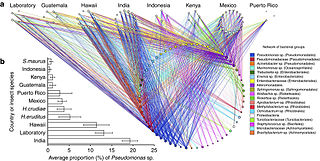
Arabidopsis thaliana, the thale cress, mouse-ear cress or arabidopsis, is a small flowering plant native to Eurasia and Africa. A. thaliana is considered a weed; it is found by roadsides and in disturbed land.

Polyhydroxybutyrate (PHB) is a polyhydroxyalkanoate (PHA), a polymer belonging to the polyesters class that are of interest as bio-derived and biodegradable plastics. The poly-3-hydroxybutyrate (P3HB) form of PHB is probably the most common type of polyhydroxyalkanoate, but other polymers of this class are produced by a variety of organisms: these include poly-4-hydroxybutyrate (P4HB), polyhydroxyvalerate (PHV), polyhydroxyhexanoate (PHH), polyhydroxyoctanoate (PHO) and their copolymers.

Pseudomonas syringae is a rod-shaped, Gram-negative bacterium with polar flagella. As a plant pathogen, it can infect a wide range of species, and exists as over 50 different pathovars, all of which are available to researchers from international culture collections such as the NCPPB, ICMP, and others.
Pseudomonas blatchfordae is a Gram-negative soil bacteria isolated from tomato pith necrosis and the common bean. It is not a validly recognized species. Based on 16S rRNA analysis, it falls within the P. fluorescens group.
Pseudomonas brassicacearum is a Gram-negative soil bacterium that infects the roots of Brassica napus, from which it derives its name. Based on 16S rRNA analysis, P. brassicacearum falls within the P. fluorescens group. It has also been shown to have both pathogenic and plant growth-promoting effects on tomato plants.

Pseudomonas fulva is a Gram-negative environmental bacterium, originally isolated from rice and commonly associated with rice plants, grains and paddy fields. It is rod-shaped and motile using one to three polar flagella.
Pseudomonas veronii is a Gram-negative, rod-shaped, fluorescent, motile bacterium isolated from natural springs in France. It may be used for bioremediation of contaminated soils, as it has been shown to degrade a variety of simple aromatic organic compounds. Based on 16S rRNA analysis, P. veronii has been placed in the P. fluorescens group.
Pseudomonas amygdali is a Gram-negative plant pathogenic bacterium. It is named after its ability to cause disease on almond trees. Different analyses, including 16S rRNA analysis, DNA-DNA hybridization, and MLST clearly placed P. amygdali in the P. syringae group together with the species Pseudomonas ficuserectae and Pseudomonas meliae, and 27 pathovars of Pseudomonas syringae/Pseudomonas savastanoi, constituting a single, well-defined phylogenetic group which should be considered as a single species. This phylogenetic group has not been formally named because of the lack of reliable means to differentiate it phenotipically from closely related species, and it is currently known as either genomospecies 2 or phylogroup 3. When it is formally named, the correct name for this new species should be Pseudomonas amygdali, which takes precedence over all the other names of taxa from this group, including Pseudomonas savastanoi, which is and inadequate and confusing name whose use is not recommended.
Pseudomonas cedrina is a Gram-negative, rod-shaped bacterium isolated from spring waters in Lebanon. Based on 16S rRNA analysis, P. cedrina has been placed in the P. fluorescens group.
Pseudomonas orientalis is a Gram-negative, rod-shaped bacterium isolated from spring waters in Lebanon. Based on 16S rRNA analysis, P. orientalis has been placed in the P. fluorescens group.
Pseudomonas mandelii is a fluorescent, Gram-negative, rod-shaped bacterium isolated from natural spring waters in France. Based on 16S rRNA analysis, P. mandelii has been placed in the P. fluorescens group.
Pseudomonas gessardii is a fluorescent, Gram-negative, rod-shaped bacterium isolated from natural mineral waters in France. Based on 16S rRNA analysis, P. gessardii has been placed in the P. fluorescens group.
Pseudomonas borbori is an aerobic, Gram-negative, nonfluorescent, nonsporulating, motile, rod-shaped bacterium isolated from a nitrifying inoculum used in aquaculture. Based on 16S rRNA phylogenetic analysis, P. borbori was placed in the P. aeruginosa group.

Arogenate dehydratase (ADT) (EC 4.2.1.91) is an enzyme that catalyzes the chemical reaction

Hyaloperonospora arabidopsidis is a species from the family Peronosporaceae. It is an obligate parasite and the causal agent of the downy mildew of the plant model organism Arabidopsis thaliana. While H. arabidopsidis has for a long time been subsumed under Peronospora parasitica, recent studies have shown that H. parasitica is restricted to Capsella bursa-pastoris as a host plant. Like the other Hyaloperonospora species, H. arabidopsidis is highly specialized to Arabidopsis thaliana.
Martin Edward Kreitman is an American geneticist at the University of Chicago, most well known for the McDonald–Kreitman test that is used to infer the amount of adaptive evolution in population genetic studies.
Methylobacterium longum is a facultative methylotrophy bacteria from the genus of Methylobacterium which has been isolated from the phyllosphere from the plant Arabidopsis thaliana in Spain.
Dyadobacter is a genus of gram negative rod-shaped bacteria belonging to the family Cytophagaceae in the phylum Bacteroidetes. Typical traits of the genus include yellow colony colour, positive flexirubin test and non-motile behaviours. They possess an anaerobic metabolism, can utilise a broad range of carbon sources, and test positive for peroxide catalase activity. The type species is Dyadobacter fermentans, which was isolated from surface sterilised maize leaves,.
Novosphingobium arabidopsis is a Gram-negative, rod-shaped and aerobic bacterium from the genus of Novosphingobium which has been isolated from the rhizosphere of the plant Arabidopsis thaliana. Novosphingobium arabidopsis is resistant against dichlorodiphenyltrichloroethane (DDT).
Microbacterium yannicii is a Gram-positive, rod-shaped, microaerophilic and non-motile bacterium from the genus of Microbacterium which has been isolated from roots of the plant Arabidopsis thaliana in Golm in Germany.





